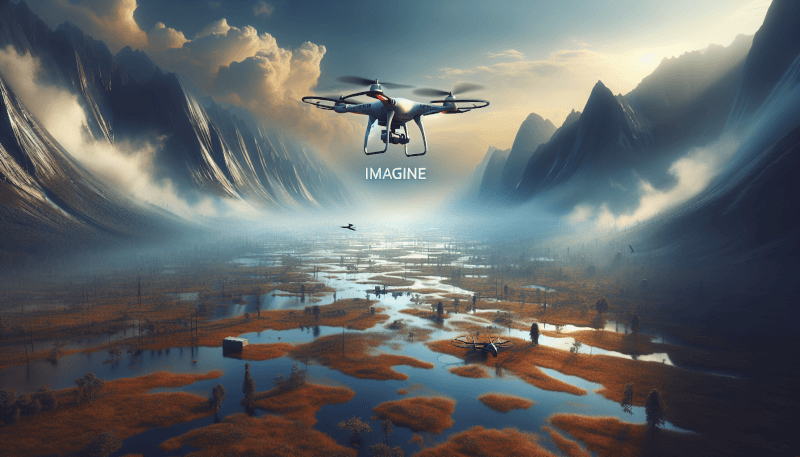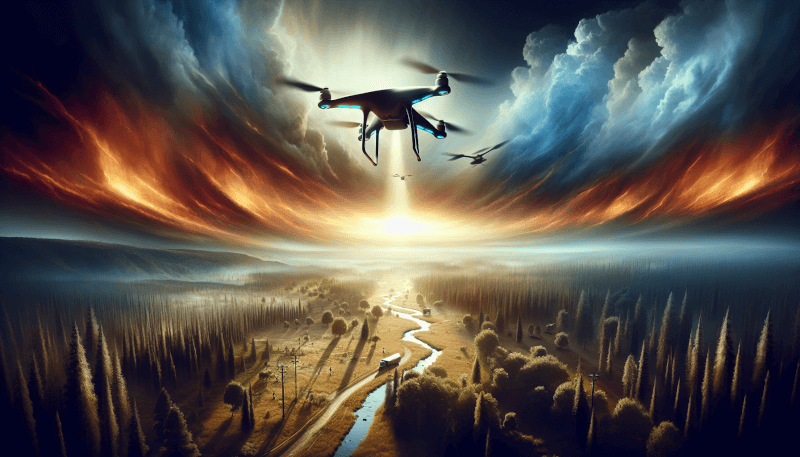In the ever-evolving world of technology, there is one device that is proving to be an invaluable asset in search and rescue missions: drones. These unmanned aerial vehicles have become essential tools that can quickly and efficiently navigate through challenging terrains, providing vital assistance when time is of the essence. With their ability to cover vast areas, access hard-to-reach locations, and capture real-time data, drones are revolutionizing the way search and rescue operations are carried out. Join us as we explore the reasons why drones have become an indispensable part of these critical missions.

Reducing Response Time
Faster Deployment
Drones have revolutionized search and rescue missions by significantly reducing response time. Traditionally, search operations could take hours or even days, depending on the size of the area to cover and the number of rescuers available. However, with the introduction of drones, the deployment process has become much faster and more efficient.
By using drones, search and rescue teams can quickly launch the aircraft from a central location and deploy them to the desired search area within minutes. This eliminates the need for extensive preparation and transportation of equipment to remote or challenging locations. In urgent situations, every second counts, and drones offer a rapid response solution to save valuable time.
Ability to Avoid Traffic
Another advantage of using drones in search and rescue operations is the ability to avoid traffic congestion. In densely populated areas or during rush hours, ground transportation can be hindered by heavy traffic, resulting in delayed response times. However, drones can bypass these obstacles and reach the destination directly, even when roads are congested.
By taking to the skies, drones can swiftly navigate through urban areas, bypassing traffic jams and other obstacles that might impede the progress of traditional search and rescue vehicles. This efficiency in movement enables emergency responders to reach the scene quickly and efficiently, improving the chances of locating and rescuing individuals in distress.
Greater Coverage Area
Drones provide search and rescue teams with the capability to cover a larger area in a shorter amount of time. In the past, search operations relied heavily on foot patrols and helicopters, which had limited coverage capabilities. Foot patrols often faced terrain challenges, while helicopters had to deal with fuel restrictions and limited flight time.
With drones, search and rescue teams can now perform wider and more comprehensive sweeps of the target area. Equipped with advanced mapping and navigation systems, these unmanned aerial vehicles can quickly search larger areas, including rugged terrains and dense forests, providing a wider scope for search operations. This increased coverage area significantly enhances the overall efficiency of search and rescue missions.
Enhancing Situational Awareness
Real-Time Video Feed
One of the key advantages of drones in search and rescue missions is the ability to provide real-time video feed to search and rescue teams. Drones are equipped with high-definition cameras that transmit live video footage to the operators on the ground. This live feed allows search teams to have a clear and up-to-the-minute understanding of the incident scene, enabling them to make informed decisions.
Real-time video feed helps search and rescue teams to identify potential dangers, assess the condition of individuals in distress, and formulate effective rescue strategies. It provides valuable situational awareness, even in challenging environments or hard-to-reach locations, ultimately saving lives.
High-Resolution Imagery
In addition to real-time video feed, drones can capture high-resolution imagery that aids in search and rescue operations. These images provide detailed information about the incident scene, including terrain conditions, geographical features, and potential hazards. With this visual data, search teams can identify the most accessible paths, locate vantage points for better observation, and determine the best approach for rescue operations.
High-resolution imagery obtained by drones enhances the situational awareness of search and rescue teams, enabling them to make critical decisions based on accurate and up-to-date information. It allows for more efficient resource allocation and ensures the safety of rescuers and those in need.
Thermal Imaging
Thermal imaging technology is another valuable feature of drones in search and rescue missions. By utilizing infrared cameras, drones can detect heat signatures emitted by individuals, even in low-light or obscured conditions. This capability is especially crucial in nighttime operations or when searching for missing persons in challenging terrains.
Thermal imaging allows search and rescue teams to quickly locate individuals in distress, identify their exact position, and determine their physical condition. This technology significantly improves the efficiency and effectiveness of search operations, increasing the chances of successful rescues, especially in situations where time is of the essence.
Navigating Challenging Environments
Accessing Remote or Dangerous Locations
One of the significant advantages of drones in search and rescue missions is their ability to access remote or dangerous locations that are otherwise difficult or unsafe to reach for human responders. Whether it’s a rugged mountain range, dense forest, or disaster-stricken area, drones can effortlessly navigate through these challenging environments and reach areas where traditional search teams may encounter obstacles.
Equipped with advanced obstacle avoidance systems and capable of vertical takeoff and landing, drones can access areas that are physically inaccessible or pose risks to human rescuers. This capability facilitates faster and safer search operations, reducing the chances of injuries or accidents to the rescue team.
Ability to Fly in Extreme Weather Conditions
Drones play a crucial role in search and rescue operations by providing assistance even in extreme weather conditions. When natural disasters strike, the conditions may be too hazardous for human responders to operate safely. However, drones can withstand and operate in these challenging environments, including heavy rain, strong winds, and even hurricanes.
With their stability, maneuverability, and waterproof capabilities, drones can continue to gather crucial information during severe weather events. They can assess the extent of damage, identify areas of highest priority, and provide real-time updates to emergency response teams. This resilience and adaptability make drones indispensable in search and rescue missions, enabling continuous operations in adverse weather conditions.
Operational Flexibility
Drones provide search and rescue teams with operational flexibility, allowing them to respond to a wide range of situations effectively. Unlike manned aircraft, which require significant resources and preparation time, drones can be deployed quickly and tailored to various mission requirements.
Whether it’s providing aerial surveillance, delivering emergency supplies, or executing search algorithms, drones can seamlessly adapt to different mission objectives. This flexibility allows search and rescue teams to optimize their operations, respond to dynamic situations, and allocate resources efficiently. Drones ensure that search and rescue missions are carried out with the utmost effectiveness and are not limited by traditional operational constraints.
Improving Efficiency in Search Operations
Automated Searching Algorithms
The introduction of drones has revolutionized search operations by incorporating automated searching algorithms. These algorithms enable drones to systematically and effectively search large areas, significantly reducing the time and effort required to locate individuals in distress.
Equipped with advanced image recognition and artificial intelligence capabilities, drones can autonomously analyze aerial footage and identify potential targets or objects of interest. This automation eliminates the need for manual reviewing of extensive video footage and allows search teams to focus on the critical aspects of the rescue operation.
By incorporating these automated searching algorithms, drones enhance the efficiency of search operations, enabling faster and more accurate identification of individuals in need of rescue.
Multi-drone Cooperation
Another significant advancement in search and rescue operations is the ability to deploy multiple drones simultaneously, working in cooperation with each other. This multi-drone cooperation enhances the efficiency and coverage capabilities of search operations, allowing teams to cover larger areas in less time.
Coordinated drones can employ formation flying techniques, where they maintain a specific formation to maximize coverage and reduce overlap. They can also communicate with each other, sharing real-time information and coordinating their movements to ensure thorough search patterns. This collaboration enables search and rescue teams to optimize their efforts and increase the chances of locating missing individuals efficiently.
Improved Communication and Coordination
Drones facilitate improved communication and coordination between search and rescue teams, enhancing the overall efficiency of operations. By acting as a communication hub in the field, drones can establish and maintain real-time communication links between ground teams, incident commanders, and other relevant stakeholders.
Equipped with communication devices and capabilities, drones can relay critical information, including video feeds, GPS coordinates, and situational updates in real-time. This seamless communication ensures that all members of the search and rescue operation are well-informed and enables effective coordination of resources and efforts.
Furthermore, drones can act as an aerial relay station, extending the communication range and coverage area beyond the capabilities of traditional ground-based systems. This enhanced communication contributes to better decision-making, improved situational awareness, and overall operational efficiency.

Enhancing Safety for Search and Rescue Teams
Reducing Physical Risks and Fatigue
Drones play a vital role in enhancing the safety of search and rescue teams by reducing physical risks and fatigue associated with traditional search operations. Ground patrols and helicopter crews often face perilous conditions, rugged terrains, and unpredictable hazards, putting their safety at risk.
With the deployment of drones, human responders can minimize their exposure to dangerous situations and focus on critical decision-making roles. Drones can collect data, navigate hazardous areas, and cover extensive terrains without risking the lives of search and rescue team members.
Furthermore, drones reduce the physical fatigue endured by human rescuers during lengthy search operations. Instead of walking for hours on end or flying in demanding conditions, operators of drones can fly and control the aircraft from a central location, eliminating physical exhaustion and ensuring that search and rescue teams remain alert and focused throughout the mission.
Enhanced Communication with Ground Teams
Drones provide search and rescue teams with enhanced communication capabilities, bridging the gap between aerial and ground-based operations. By relaying real-time information to and from ground teams, drones enable seamless and efficient communication, enhancing the safety and effectiveness of search operations.
In situations where ground teams may require immediate assistance, drones can quickly deliver critical information, emergency supplies, or additional resources. This direct communication allows for faster response times, resulting in improved safety for both the search and rescue teams and the individuals in distress.
Emergency Supplies Delivery
Drones have the ability to deliver emergency supplies, such as first aid kits, water, or food, to individuals in need during search and rescue operations. This capability is particularly valuable in remote or inaccessible areas, where traditional means of supply delivery may be challenging or time-consuming.
Equipped with payloads and specialized attachments, drones can swiftly transport essential supplies to individuals in distress, providing life-saving assistance until ground teams can reach them. This rapid delivery of emergency supplies not only enhances safety but also increases the chances of survival for those awaiting rescue.
Cost-Effectiveness and Sustainability
Lower Operating Costs
Drones offer a cost-effective solution for search and rescue missions, significantly reducing operating costs compared to traditional methods. Manned aircraft, such as helicopters, require substantial financial resources for fuel, maintenance, and personnel. On the other hand, drones are relatively inexpensive to operate and maintain, making them an economical choice for search and rescue operations.
By utilizing drones, search and rescue teams can allocate their limited budgets more efficiently, ensuring that resources are utilized where they are most needed. These cost savings allow for increased investment in training, technology upgrades, and other critical aspects of search and rescue operations, ultimately improving overall mission effectiveness.
Reduced Environmental Impact
Drones contribute to reducing the environmental impact of search and rescue operations. Manned aircraft, especially helicopters, emit greenhouse gases and consume significant amounts of fuel, thereby contributing to air pollution and carbon emissions.
In contrast, drones are typically electric-powered, resulting in lower emissions and reduced environmental footprint. This eco-friendly aspect of drones aligns with the global push for sustainability and enables search and rescue missions to be conducted in a more environmentally responsible manner.
Longer Mission Durations
Drones have the advantage of longer mission durations compared to manned aircraft. Traditional search and rescue operations with helicopters are often limited by fuel capacity and flight time restrictions, requiring frequent refueling and operational downtime.
Drones, on the other hand, can be equipped with larger batteries or utilize efficient power systems that allow for extended flight times. This capability enables drones to stay in the air for more extended periods, increasing the overall duration and effectiveness of search and rescue missions. Longer mission durations translate to more comprehensive coverage, enhanced situational awareness, and a higher likelihood of successful outcomes.

Overcoming Challenges and Limitations
Legal and Regulatory Frameworks
The widespread use of drones in search and rescue operations has led to the formulation of legal and regulatory frameworks to address safety and privacy concerns. These frameworks ensure that drones are operated safely and responsibly, mitigating the risks associated with their use.
Search and rescue teams must comply with these regulations, which may include obtaining appropriate licenses or permits, adhering to flight restrictions, and ensuring pilot certification. Overcoming these legal and regulatory challenges is essential to ensure the safe and effective integration of drones into search and rescue operations.
Privacy Concerns
While drones provide significant benefits in search and rescue missions, there are legitimate concerns about privacy. The aerial surveillance capabilities of drones may raise concerns regarding the protection of individuals’ privacy rights, especially in residential areas or during sensitive operations.
To address these concerns, search and rescue teams must establish clear guidelines and protocols for drone operations to respect privacy rights and maintain public trust. This includes limiting aerial surveillance to areas where genuine search and rescue operations are being conducted and ensuring that collected data is used solely for operational purposes.
Skills and Training Requirements
Operating drones for search and rescue missions requires specialized skills and training. Search and rescue teams must invest in training programs to develop the necessary expertise in drone operation, maintenance, and mission planning.
Specific skills, such as piloting drones, analyzing aerial imagery, and understanding search algorithms, are essential for effective use of drones in search operations. Training programs should also cover topics related to safety procedures, legal compliance, and ethical considerations to ensure that search and rescue teams can utilize drones to their fullest potential.
Future Developments and Integration
Artificial Intelligence
The integration of artificial intelligence (AI) capabilities into drones holds promising prospects for search and rescue operations. AI algorithms can enhance the autonomy and decision-making capabilities of drones, enabling them to conduct more advanced search patterns, analyze complex data, and adapt to dynamic situations.
AI-powered drones have the potential to process vast amounts of data in real-time, identify patterns or anomalies, and prioritize search areas based on predicted probabilities. This integration of AI technology will revolutionize search and rescue missions, enabling more efficient and accurate identification of individuals in distress.
Sensor Technology Advancements
Advancements in sensor technology are expected to play a significant role in improving the effectiveness of drones in search and rescue operations. Sensors such as gas detectors, chemical sensors, and radiation detectors can be integrated into drones, allowing for early detection of hazardous substances or dangerous environments.
These sensors can provide critical information to search and rescue teams, enabling them to make informed decisions regarding evacuation, containment, or specialized response actions. Enhancements in sensor technology will further expand the capabilities of drones, enabling them to tackle a broader range of search and rescue challenges.
Integration with Other Technologies
Drones can be integrated with other emerging technologies to enhance their capabilities in search and rescue missions. For example, the integration of drones with virtual reality (VR) or augmented reality (AR) systems can provide search teams with enhanced visualization tools, enabling them to navigate complex or hazardous environments safely.
Additionally, the integration of drones with robotics technology allows for the deployment of ground-based robots in conjunction with aerial drones. This combination of aerial and ground-based assets can provide a more comprehensive and efficient approach to search and rescue operations, especially in scenarios that require complex coordination and specialized equipment.

Successful Use Cases
Rescuing Lost Hikers and Campers
Drones have proven highly successful in rescuing lost hikers and campers, especially in remote or challenging terrains. By rapidly deploying drones equipped with high-resolution cameras and thermal imaging, search and rescue teams can quickly locate individuals who may have wandered off path or encountered emergencies.
The real-time video feed and high-resolution imagery provided by drones assist in identifying the exact location of the lost individuals, enabling ground teams to navigate to their position swiftly. Drones also provide a valuable aerial perspective, allowing search teams to identify potential hazards and determine the safest routes for rescue operations.
Locating Missing Persons
Drones have significantly improved the efficiency of locating missing persons, accelerating search operations and increasing the chances of successful outcomes. Equipped with advanced search algorithms, drones can systematically scan large areas, including dense forests, urban environments, or disaster-stricken zones.
The automated searching capabilities of drones, combined with real-time video feed and high-resolution imagery, help search teams identify and locate missing persons within a shorter timeframe. This timely identification improves the chances of finding individuals before the situation worsens, ultimately saving lives.
Assisting in Natural Disasters
Drones have become invaluable tools in assisting search and rescue efforts during natural disasters. In situations such as earthquakes, hurricanes, or floods, traditional search and rescue methods may be hampered by restricted access, dangerous conditions, or limited resources.
Drones can quickly and safely navigate disaster-stricken areas to assess damage, locate survivors, and identify critical infrastructure in need of repair. These aerial platforms provide real-time data to emergency response teams, enabling them to prioritize rescue efforts, allocate resources efficiently, and coordinate response actions effectively.
Conclusion
Drones have emerged as essential tools in search and rescue missions, revolutionizing the way emergency responders locate and rescue individuals in distress. Their ability to reduce response time, enhance situational awareness, navigate challenging environments, improve search efficiency, enhance safety for search teams, and provide cost-effective and sustainable solutions has transformed search and rescue operations.
By continuously pushing the boundaries of technology and addressing challenges such as legal frameworks, privacy concerns, and training requirements, drones are set to play an even more critical role in the future. With advancements in artificial intelligence, sensor technology, and integration with other emerging technologies, drones will further enhance their capabilities, making them indispensable assets in search and rescue missions worldwide.



